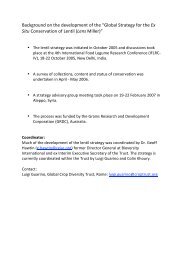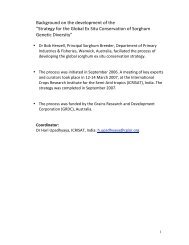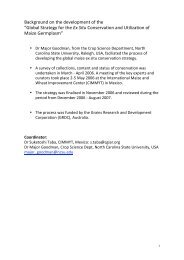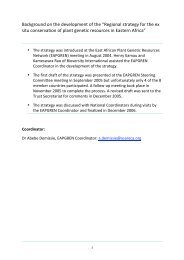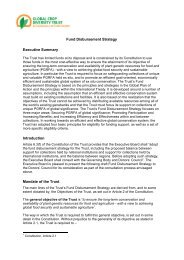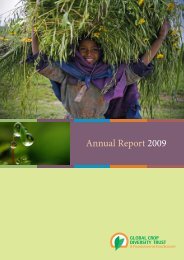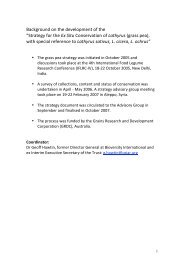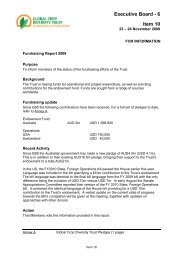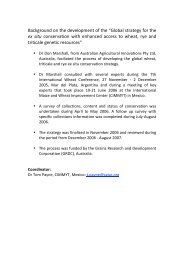Global Strategy for the Ex Situ Conservation of Potato - Global Crop ...
Global Strategy for the Ex Situ Conservation of Potato - Global Crop ...
Global Strategy for the Ex Situ Conservation of Potato - Global Crop ...
Create successful ePaper yourself
Turn your PDF publications into a flip-book with our unique Google optimized e-Paper software.
Documentation <strong>of</strong> evaluation data is not yet common practice and only a few potato<br />
collections make <strong>the</strong>se data available on <strong>the</strong> Internet.<br />
Access through Internet<br />
Passport data <strong>of</strong> <strong>the</strong> collections <strong>of</strong> wild species <strong>of</strong> 10 major genebanks are accessible<br />
through <strong>the</strong> Internet (Table 12, Annex 4). The passport data <strong>of</strong> native cultivars <strong>of</strong> nine<br />
collections, and cultivars <strong>of</strong> Solanum tuberosum spp. tuberosum <strong>of</strong> 15 collections (mainly<br />
from Europe <strong>of</strong> which some holders did not complete <strong>the</strong> questionnaire) can also be found on<br />
<strong>the</strong> Internet. (Tables 1 and 4, Annex 5)) Only few potato collections make characterisation<br />
and evaluation data available on <strong>the</strong> Internet. However, as outlined in <strong>the</strong> paragraphs 5.4.8<br />
and 5.6, various external stakeholders regularly make use <strong>of</strong> <strong>the</strong> evaluation data available in<br />
<strong>the</strong> few on-line searchable databases.<br />
5.4.6 Storage and maintenance (true seeds, tubers and in vitro).<br />
Storage methods <strong>of</strong> potato germplasm depend on <strong>the</strong> type <strong>of</strong> germplasm. Wild relatives are<br />
generally stored in <strong>the</strong> <strong>for</strong>m <strong>of</strong> true seeds. Occasionally, native cultivars <strong>of</strong> <strong>the</strong> centre <strong>of</strong><br />
diversity are also stored as populations (true seeds), but this is no general practice in <strong>the</strong><br />
Latin American region.<br />
Fifteen genebanks maintain ex situ storage facilities. Ten collections have long-term storage<br />
facilities (-10 to –20 ºC) and nine have medium-term facilities <strong>for</strong> true seed conservation. Five<br />
genebanks have both facilities <strong>for</strong> storing <strong>the</strong> base collections under long-term conditions<br />
and keeping <strong>the</strong> active collections under medium-term conditions (Table 8, Annex 4). The<br />
type <strong>of</strong> packaging <strong>of</strong> seeds in ex situ genebanks varies, several holders use aluminium foil<br />
bags, but plastic, paper bags and bottles are used as well.<br />
The native cultivars and germplasm <strong>of</strong> S. tuberosum spp. tuberosum cultivars are normally<br />
vegetatively conserved; both seed potato and in vitro storage are employed.<br />
The conditions <strong>of</strong> seed potato storage in cold rooms vary considerably. Temperature in <strong>the</strong><br />
cold stores varies from 2 to 14 ºC, 13 genebanks using 4 ºC facilities. The relative humidity in<br />
<strong>the</strong> cold stores varies from 30 to 95 %; most common RH is around 70 %. Seventeen<br />
genebanks have in vitro facilities <strong>for</strong> storage <strong>of</strong> cultivated material, whereas occasionally<br />
accessions <strong>of</strong> wild species are stored in vitro as well. Cryopreservation is not a common<br />
practice yet, although two genebanks conduct research to fur<strong>the</strong>r develop this method fur<strong>the</strong>r<br />
<strong>for</strong> cloned material.<br />
5.4.7 Health <strong>of</strong> potato germplasm<br />
Distribution <strong>of</strong> potato germplasm, a common practice <strong>for</strong> most genebanks (see 5.4.8), is<br />
regularly hampered by infection <strong>of</strong> <strong>the</strong> germplasm. <strong>Potato</strong> germplasm can be infected by a<br />
substantial number <strong>of</strong> pathogens. The two most common and types <strong>of</strong> infection harmful <strong>for</strong><br />
distribution are:<br />
! seed-borne viral diseases (only relevant <strong>for</strong> true seed collections), in particular PSTVd<br />
and PVT, in Europe also PMT, PVR, APLV, APMoV;<br />
! tuber-borne viral infections (most important viruses PLRV, PVS, PVX, PVY and PVM).<br />
•<br />
Five curators stated that collection have not been affected at all, whereas in 17 genebanks<br />
germplasm has been infected to some extent (Table 9, Annex 4). Tuber infection is<br />
mentioned particularly, only five genebanks mentioning problems with seed-borne diseases.<br />
The limited reporting <strong>of</strong> seed-borne diseases is partly <strong>the</strong> result <strong>of</strong> quarantine regulations,<br />
prohibiting movement <strong>of</strong> germplasm without a certificate, but also because not all collections<br />
screen <strong>for</strong> such diseases, which may result in under-reporting.<br />
14




